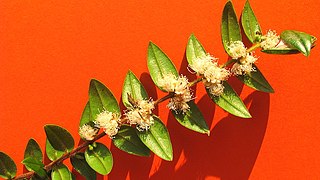
Myrciaria floribunda, commonly known as cambuizeiro, guavaberry or rumberry, is a species of plant in the family Myrtaceae. It can be found across South and Central America and the West Indies in dry or moist coastal woodlands, up to 300 metres above sea level. The guavaberry, which should not be confused with the guava, is a close relative of camu camu.

Cauliflory is a botanical term referring to plants that flower and fruit from their main stems or woody trunks, rather than from new growth and shoots. It is rare in temperate regions but common in tropical forests.

Jabuticaba, also spelled Jaboticaba, is the edible fruit of the jabuticabeira or Brazilian grapetree. The purplish-black, white-pulped fruit grows directly on the trunk of the tree, making it an example of 'cauliflory'. It is eaten raw or used to make jellies, jams, juice or wine. The tree, of the family Myrtaceae, is native to the states of Rio de Janeiro, Minas Gerais, Goiás and São Paulo in Brazil. Related species in the genus Myrciaria, often referred to by the same common names, are native to Brazil, Argentina, Paraguay, Peru and Bolivia.

Myrciaria is a genus of large shrubs and small trees described as a genus in 1856. It is native to Central and South America, Mexico, and the West Indies, with many of the species endemic to Brazil. Common names include hivapuru, sabará, and ybapuru.

Plinia is a genus of flowering plants in the myrtle family, Myrtaceae described by Linnaeus in 1753. It is native to Central and South America as well as the West Indies.
Calycorectes is a genus of plant in family Myrtaceae first described as a genus in 1856. It is native to South America, southern Mexico, and the Dominican Republic.

Myrteae is the largest tribe in the plant family Myrtaceae. It includes most of the species of the family that have fleshy fruits.
Plinia phitrantha, commonly known as jaboticaba branca or ibatinga , is a species of plant in the family Myrtaceae. It is endemic to the states of São Paulo and Minas Gerais in south-eastern Brazil. The tree grows to between 2 and 7 metres tall, and produces edible fruit, between 10 and 25mm in diameter, which is green in colour due to a lack of anthocyanins in the skin.

Myrciaria glazioviana, the cabeluda, or yellow jaboticaba, is a species of plant in the family Myrtaceae.
Plinia grandifolia, commonly known as jaboticaba graúda, is a species of plant in the family Myrtaceae. It is endemic to south-eastern Brazil, and is found almost exclusively in the under-story of the Atlantic Rainforest. The tree grows to between 4 and 8 metres tall, and produces dark-purple, edible fruit, between 15 and 25mm in diameter.

Plinia peruviana, commonly known as jabuticaba cabinho in Brazil, is a species of plant in the family Myrtaceae. It is endemic to central, South America.
Plinia coronata, commonly known as jaboticaba coroada, is a species of plant in the family Myrtaceae. It is endemic to south-eastern Brazil. The tree grows to between 4 and 12 metres tall, and produces purple, edible fruit, which is between 25 and 30mm in diameter.
Plinia oblongata, commonly known as jaboticaba azeda, is a species of plant in the family Myrtaceae. It is endemic to south-eastern Brazil. The tree grows to between 4 and 6 metres tall, and produces dark-purple, acidic but edible fruit, which is between 25 and 30mm in diameter.
Plinia rogersiana is a species of plant in the family Myrtaceae. It is endemic to the state of São Paulo in the south-east of Brazil. It is considered critically endangered, possibly extinct.

Myrciaria strigipes, commonly known as cambucá da praia or cabeludinha da praia, is a species of plant in the family Myrtaceae. It is an evergreen shrub or small tree, endemic to Bahia and Espírito Santo in the east of Brazil. The plant grows up to between 4 and 9 metres tall, and produces edible yellowish fruits between 22 and 28mm in diameter. Consumed raw, the fruit has been described as tasting somewhere between Myrciaria glazioviana and Plinia cauliflora.
Plinia martinellii, commonly known as jabuticabinha da mata, is a species of plant in the family Myrtaceae. It is endemic to the Atlantic Rainforest in the state of Rio de Janeiro, Brazil. This small tree produces dark blue-black fruits, around 20mm in diameter.
Plinia rivularis, commonly known as yva poroity, jaboticabarana, jabúriti, guapuriti, cambucá peixoto, jabuticaba de cacho, or piuna is a species of plant in the family Myrtaceae.
Myrciaria guaquiea, commonly known as guaquica or ibá-cuíca, is a species of plant in the family Myrtaceae. It is an evergreen shrub or small tree, endemic to the east of Brazil. The plant grows up to between 4 and 7 metres tall, and produces edible yellow fruits between 20 and 25mm in diameter. Consumed raw, the fruit has been described as tasting similar to Myrciaria glazioviana.
Myrciaria tenella, commonly known as cambuí or camboim, which are also used to describe Myrciaria cuspidata and Myrciaria delicatula; or more specifically jabuticaba-macia, and cambuí-açu, is a species of plant in the family Myrtaceae.








